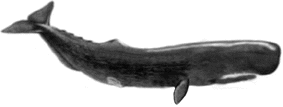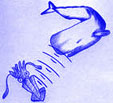|
SPERM
WHALE |
|

|
|
SCIENTIFIC
NAME
- Physeter from the greek physao "blow",
catodon from the greek cata "low" and odon "tooth";
so "blower with teeth only on the lower jaw".
|
|
FAMILY
- Physeteridae
|
| DIMENSIONS
- The female is smaller of the male, the maximum length
18.3 mt, weight 57 t. |
| ASPECT
- Squared and enormous Head (1/3 of the
entire body) compressed laterally; long and thin jaw under the head; airhole in position advanced on the top of the rostrum a little
on the left; triangular low dorsal fin with dulled apex; dorsal
crest with hunchbacks; wide tail much and triangular one; short and
increased pectoral fins. |
| SKIN
and COLORATION - Wrinkled and
waved, grey dark with tawny shadings, rare white spots on the
body (rarest exemplary albinos that have inspired the "Moby Dick")
white contour of the mouth. |
| LONGEVITY
- Until 70 years. |
| REPRODUCTION
- No migrations, the conceivment happens between half winter
and half summer and the birth of the puppy after approximately 15
months in spring-summer. The sociality of the species manifest
during the delivery, moment in which all the members of the branch
collaborate. At the birth the puppy measure approximately 4 mt
and hung approximately 600 Kg. |
| TEETH
- Approximately 50 of the weight 500 gr.
and high 25 cm. |
| BREATH
- In ahead and on the left, low and
lacking in a very precise shape. |
| SOUNDS
- The vocalizations are few
produce a sound to impulses (as an hammer) when it is
dipped. |
FEEDING
- Fish and squids constitute the diet of the
sperm whale in different percentages to second of the seas in which
feeds; the greatest predator of the earth engages true and own
battles with the Architeuthis (the giant squid that can catch up the
15-20 mt. of length), but normally it is pleased of preys under the
meter of length. On the hunting techniques
 supposition are
made by now of sure is known only that the preys are searched
until -2000 mt of depth and beyond; there's who imagines a static predatoran attending
that preys grazes it jaw; who thinks instead
that the sperm whale casts on the preys attracted from their flares;
who thinks that the preys are stunned with strong sonorous
emissions; who assumes that the preys come devoured, and who
that comes aspired, in such case the teeth would only serve to immobilize (Vd. Feeding). supposition are
made by now of sure is known only that the preys are searched
until -2000 mt of depth and beyond; there's who imagines a static predatoran attending
that preys grazes it jaw; who thinks instead
that the sperm whale casts on the preys attracted from their flares;
who thinks that the preys are stunned with strong sonorous
emissions; who assumes that the preys come devoured, and who
that comes aspired, in such case the teeth would only serve to immobilize (Vd. Feeding). |
| HABITAT
- Cetacean that is usual to swim in overhanging
waters the continental escarpment habitat of its preys. |
SWIM
- Swims habitually rather slow to approximately 7km/h (4 nodes) but for
short drawn catches up the maximum speed of 22 Km/h (15 nodes), often
is firm. Given the nature  of predator of the abysses in surface
is rested and taken breath for the successive immersion; this will be
easy evident extraction of the tail. In
immersion the dowries of the sperm whale are shown with advanced depths
to i -2000 mt and durations of apnea beyond the 2 hours. of predator of the abysses in surface
is rested and taken breath for the successive immersion; this will be
easy evident extraction of the tail. In
immersion the dowries of the sperm whale are shown with advanced depths
to i -2000 mt and durations of apnea beyond the 2 hours.
|
|

|
| JUMPS
- Enough frequent, very spectacular with emersion of nearly
all body, with return on a flank or also of head. |
|
MIGRATIONS
- Migrations in winter in moderated and tropical waters while in
summer migrates towards cold zones as the sub-polar. The males and
the females with the puppy often complete separated migratory
movements.
|
|
SOCIALITY
- Very social odontocet, stretches to form
groups of two types, first of bachelor males (of ransom and age
similar), the second of females with puppies (in number often
around to the 20 exemplary or more); in other cases the large males
are solitary. The permanence of the prole for much time in the
group (in order always in the females and until the maturity for the
males), favors stable ties and facility of learning. The cooperation
makes part of the instinct of branch of the sperm whale and manifest for
example in breast-feeding in common.
|
|
TEMPERAMENT
- Indifferent to the man
and the boats if annoyed can become aggressive, curious
and confiding puppies that stretch sometimes to get close to the boats for
observing.
|
|
DANGER
and PREDATORY
- Sometimes attacks from part of
killer whales (in Arctic waters) to puppies and females (is assumed also from
part of large sharks), the great males are practically immune from the
predation; often they die for intrapment in deriving networks.
Sometimes victim also of collectives beachings.
|
|
SPECIES
DIFFUSION
- It's numerically and geographically the most diffuse Odontocet, the world-wide population is estimated in 1.900.000
exemplary; disseminated in the seas of the austral hemisphere (beyond
780.000), in the northern Pacific (approximately 930.000) and in the
northern Atlantic (approximately 190.000). In the Mediterranean numerous
but in decrease, present above all to the West.
|
|

|